Why Public Speaking Triggers Fight-or-Flight (and How to Calm It Naturally)
Introduction
Public speaking is often ranked among the world’s most common fears—sometimes even higher than death. The sweaty palms, racing heart, dry mouth, and mental blankness are familiar to anyone who’s had to stand before an audience. But what many people don’t realize is that these reactions aren’t signs of weakness—they’re signs of biology.
When you prepare to speak in front of others, your body activates the fight-or-flight response, the same ancient survival mechanism that once kept humans safe from predators. The problem? While there’s no actual physical threat, your nervous system interprets the situation as if you’re in danger.
The good news is that you can learn to regulate this response without relying on medication or harsh avoidance. By understanding how the body works, and by using natural calming tools—breathwork, therapy, supplements, mindfulness, and nervous system regulation—you can transform public speaking from a panic-inducing ordeal into a powerful opportunity for expression.
This article will explore:
- Why public speaking feels threatening to the brain.
- How the fight-or-flight response works in this context.
- Natural ways to calm and regulate your body before, during, and after a presentation.
- Long-term strategies to build resilience and confidence.
Looking for online therapy for people with Social Anxiety? Click Here.
The Biology of Public Speaking Anxiety 🧠⚡
The Role of the Amygdala
At the heart of the fear response is the amygdala, the brain’s alarm system. When you face an audience, the amygdala quickly scans for threat. It doesn’t distinguish between a hungry lion and a room full of expectant faces—it just registers danger.
Adrenaline Surge
Once triggered, the amygdala signals the hypothalamus-pituitary-adrenal (HPA) axis, which releases adrenaline and cortisol. This creates the familiar fight-or-flight sensations:
- Increased heart rate 🫀
- Shallow, rapid breathing 😮💨
- Sweaty palms 💦
- Muscle tension 💪
- Racing thoughts 💭
Why the Body Overreacts
In ancient times, being judged or excluded by a group could threaten survival. This makes social evaluation—like public speaking—uniquely stressful. Today, your brain still treats the possibility of embarrassment or rejection as a survival-level threat.
What Fight-or-Flight Looks Like in Public Speaking 🎭

Physiological Symptoms
Voice trembling.
Dry mouth.
Rapid heartbeat.
Shaking hands.
Cognitive Symptoms
Blank mind (“I forgot everything I was going to say”).
Negative inner dialogue (“They’ll think I’m incompetent”).
Difficulty concentrating.
Behavioral Symptoms
Avoiding opportunities to speak.
Rushing through presentations.
Using filler words excessively.
Why Avoidance Makes It Worse 🚫➡️😰
When people avoid public speaking, they temporarily reduce anxiety. But long-term, avoidance reinforces fear because the brain never learns that the threat isn’t real. Exposure, regulation, and gradual practice are essential to retraining the nervous system.
Natural Calming Strategies 🌿🧘
Breathwork: Rewiring the Nervous System 🌬️
Breathing is the fastest way to communicate safety to your body.
Techniques:
Box Breathing (4-4-4-4): Inhale 4, hold 4, exhale 4, hold 4. Great before going on stage.
Extended Exhale (4-7-8): Inhale for 4, hold for 7, exhale for 8. This activates the parasympathetic nervous system.
Coherent Breathing: Slow breathing at ~5–6 breaths per minute balances heart rate and reduces cortisol.
Try practicing these daily, not just before presentations, to build nervous system flexibility.
Want to try Breathwork? Click Here.
Mind-Body Grounding Techniques 🪷
Progressive Muscle Relaxation: Tense and release muscle groups to discharge stress.
Visualization: Imagine yourself speaking calmly while the audience nods in agreement. This primes the brain to associate speaking with safety.
Power Poses: Standing tall with open posture can increase feelings of confidence and reduce cortisol.
Supplements for Calming the Stress Response 💊🌱
While not a replacement for skill-building, certain supplements may help regulate the body’s stress reaction:
L-Theanine: Found in green tea, it promotes calm alertness without sedation.
Magnesium Glycinate: Supports muscle relaxation and nervous system balance.
Ashwagandha (Adaptogen): Helps regulate cortisol and improve resilience to stress.
Omega-3 Fatty Acids: Support brain health and reduce inflammation linked to anxiety.
Chamomile or Passionflower Extracts: Mild calming herbs that can reduce nervous tension.
(Always consult a professional before starting new supplements.)
Looking for supplements for people with Social Anxiety? Click here.
Therapy Approaches 🛋️
Therapy helps uncover the roots of speaking anxiety and teaches new regulation tools.
Cognitive Behavioral Therapy (CBT): Identifies and reframes distorted thoughts (“They’ll laugh at me”).
Exposure Therapy: Gradually introduces speaking situations to retrain the brain.
Somatic Therapy / Polyvagal Work: Helps release trauma stored in the body and teaches nervous system safety.
Acceptance and Commitment Therapy (ACT): Encourages speaking even with discomfort, aligning with values rather than fear.
Looking for online therapy for people with Social Anxiety? Click Here.
Lifestyle Factors That Improve Resilience 🌞🍎
Regular Exercise: Reduces baseline anxiety by metabolizing excess stress hormones.
Consistent Sleep: Restored sleep improves emotional regulation.
Balanced Nutrition: Avoid excess caffeine or sugar before presenting. Opt for protein and slow-digesting carbs.
Hydration: Dry mouth worsens under stress; staying hydrated prevents it.
Pre-Presentation Rituals 🔑
Creating a routine helps signal safety to your body.
Example Ritual (30 minutes before speaking):
Find a quiet space and do 5 minutes of box breathing.
Do light stretching or power poses.
Sip water or herbal tea.
Mentally rehearse with positive imagery.
Repeat a calming affirmation: “My voice matters. I am safe.”
During the Presentation 🎙️
Pause and Breathe: A slow inhale-exhale before speaking each main point.
Eye Contact: Focus on one supportive listener at a time instead of the whole room.
Speak Slowly: Nerves make people rush; slow pacing signals control.
Reframe Symptoms: Racing heart = body energizing you to perform.
Post-Presentation Recovery 🌙
Even after speaking, your body may stay activated. Use your Event Recovery Stack principles here:
Breathwork to down-regulate.
Magnesium or calming tea for the evening.
Reflective journaling: Note what went well to rewire the brain for future safety.
Building Long-Term Social Resilience 🌱💪

Public speaking confidence isn’t built overnight. It requires steady nervous system training.
Join groups like Toastmasters for structured practice.
Record yourself speaking and review progress.
Practice small exposures (speak up in a meeting, volunteer a question).
Integrate calming supplements and routines into daily life—not just on presentation days.
Conclusion 🌟
Public speaking triggers fight-or-flight because your brain misinterprets social evaluation as a survival threat. But you’re not doomed to live with stage fright forever. By combining natural calming tools—breathwork, grounding, supplements, therapy, and lifestyle changes—you can regulate your nervous system and reframe public speaking into an empowering experience.
The key isn’t to eliminate adrenaline but to work with it, channeling the energy into clear, confident communication. Over time, your brain learns that speaking isn’t dangerous—and instead of survival mode, you find yourself in thriving mode.
Looking for supplements for people with Social Anxiety? Click here.
References 📚
Porges, S. W. (2017). The Pocket Guide to the Polyvagal Theory. W. W. Norton.
Hofmann, S. G., Asnaani, A., Vonk, I. J., Sawyer, A. T., & Fang, A. (2012). The efficacy of cognitive behavioral therapy: A review of meta-analyses. Cognitive Therapy and Research, 36(5), 427–440.
Spielberger, C. D. (2010). State-Trait Anxiety Inventory. APA.
Jerath, R., Edry, J. W., Barnes, V. A., & Jerath, V. (2006). Physiology of long pranayamic breathing: Neural respiratory elements may provide a mechanism that explains how slow deep breathing shifts the autonomic nervous system. Medical Hypotheses, 67(3), 566–571.
Lakhan, S. E., & Vieira, K. F. (2010). Nutritional and herbal supplements for anxiety-related disorders: Systematic review. Nutrition Journal, 9(1), 42.
Lopresti, A. L., Smith, S. J., Malvi, H., & Kodgule, R. (2019). An investigation into the stress-relieving and pharmacological actions of ashwagandha. Journal of Clinical Medicine, 8(11), 1761.
Hibbeln, J. R., et al. (2006). Omega-3 fatty acid deficiencies in neuropsychiatric disorders. Am J Psychiatry, 163(6), 969–978.
Blumenthal, J. A., et al. (2007). Exercise and pharmacotherapy in the treatment of major depressive disorder. Psychosomatic Medicine, 69(7), 587–596.
Related Posts
-

Supplements for Staying Present and Grounded
L-Theanine is nature’s calm focus enhancer 🍃. Derived from green tea, it promotes relaxation without drowsiness by balancing GABA, serotonin, and dopamine. Learn how this amino acid supports smooth focus, emotional balance, and mindful presence in daily life.
-
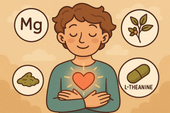
Supplements That Support Emotional Openness
Emotional openness starts in the body 🌿. When your nervous system feels safe, your heart can express freely. Learn how supplements like magnesium, Ashwagandha, and L-theanine support calm connection, balanced emotions, and the courage to stay authentically open.
-

Daily Supplement Routine for Consistent Confidence
Confidence is built through rhythm, not luck 🌿. A daily supplement routine can help your energy, mood, and focus stay balanced from morning to night. Learn how adaptogens, magnesium, and B vitamins work together to create steady calm and lasting self-assurance.
-
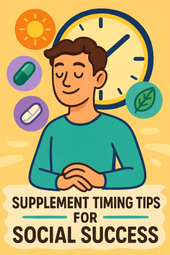
Supplement Timing Tips for Social Success
Social confidence has its own rhythm 🌿. When you time your supplements to match your body’s natural energy cycles, calm and focus align effortlessly. Learn how magnesium, L-theanine, and adaptogens can help you stay grounded, charismatic, and fully present at just the right moment.
-
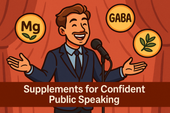
Supplements for Confident Public Speaking
Public speaking confidence begins with biology 🎤🌿. When your nervous system is calm and your neurotransmitters are balanced, your voice, focus, and presence flow naturally. Learn how supplements like magnesium, GABA, and adaptogens can align your body’s chemistry with the calm clarity you need to speak authentically.
-

Travel-Friendly Supplements for On-the-Go Confidence
Magnesium is the ultimate travel mineral for calm and balance ✈️🌿. It relaxes the nervous system, eases stress from jet lag or fatigue, and supports muscle and mental recovery. Discover how this essential nutrient keeps you centered, focused, and energized wherever your journey takes you.
-

Supplements for Confident Video Calls
Magnesium is the mineral that brings calm to both body and mind 🌿. It supports relaxation, better sleep, and a stable mood by regulating cortisol and soothing the nervous system. Learn how magnesium supplements can restore balance, reduce anxiety, and help you feel centered under stress.
-

Ashwagandha for Calming the Stress Response
Ashwagandha helps your body remember how to relax 🌿. As one of the most trusted adaptogens, it calms the stress response by lowering cortisol, soothing the nervous system, and restoring natural energy balance. Learn how this ancient herb promotes deeper sleep, emotional steadiness, and resilience in today’s high-stress world.
-

How GABA Supplements Can Help You Feel Grounded
GABA is the brain’s natural calm signal 🌿. When life feels overwhelming, this neurotransmitter helps quiet mental noise, relax muscles, and restore emotional balance. Learn how GABA supplements can calm the nervous system, reduce anxiety, and help you feel grounded in your body again.
-
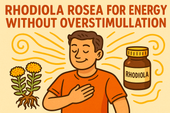
Rhodiola Rosea for Energy Without Overstimulation
Rhodiola rosea offers a rare kind of energy — one rooted in calm, not chaos 🌿. Known as the golden root, this adaptogen enhances endurance, focus, and mood by balancing cortisol and supporting the nervous system. Discover how Rhodiola restores natural vitality without the overstimulation of caffeine or stress-driven fatigue.
-
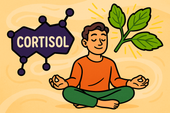
Holy Basil and Cortisol Control
Holy basil, or Tulsi, is one of nature’s most powerful adaptogens 🌿. Revered in Ayurvedic medicine for centuries, it helps balance cortisol, calm the mind, and protect the body from stress. Learn how holy basil restores hormonal harmony, supports energy, and promotes emotional resilience in a fast-paced world.
-
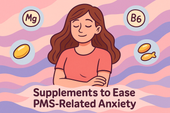
Supplements to Ease PMS-Related Anxiety
Hormones are the body’s messengers — guiding mood, energy, metabolism, and balance. 🌿 When these chemical signals flow in harmony, life feels stable and calm. Learn how nutrients, sleep, and stress management help keep hormonal communication clear, supporting emotional steadiness and overall vitality.
-
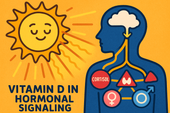
The Role of Vitamin D in Hormonal Signaling
Testosterone is more than a hormone — it’s a signal of strength, motivation, and vitality 💪. Learn how this key molecule shapes energy, mood, muscle growth, and focus in both men and women. Discover how nutrition, vitamin D, and minerals like zinc and magnesium support healthy testosterone signaling for balanced power and performance.
-
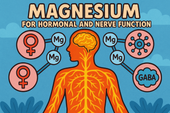
Magnesium for Hormonal and Nerve Function
Magnesium is the mineral that connects calm and vitality ⚡. It fuels nerve transmission, supports hormonal balance, and restores the body’s ability to relax under stress. Learn how magnesium strengthens communication between the nervous and endocrine systems, stabilizing cortisol, thyroid, and reproductive hormones for true equilibrium.
-

Zinc and Its Role in Hormonal Stability
Zinc is one of the body’s most powerful regulators ⚖️—a trace mineral that keeps hormones, metabolism, and energy in perfect rhythm. Learn how zinc supports testosterone, thyroid function, cortisol balance, and emotional stability while protecting against modern stress and deficiency. Discover why restoring zinc can help your body feel grounded, focused, and hormonally resilient.
-
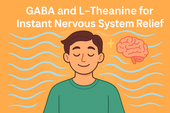
GABA and L-Theanine for Instant Nervous System Relief
When stress hits, your nervous system needs relief — not more stimulation 🌿. Discover how GABA and L-theanine work together to calm the body, quiet racing thoughts, and restore inner balance. Learn the science behind these natural compounds that ease tension, support emotional stability, and bring instant peace without sedation.
-
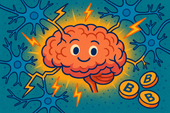
B-Vitamins for Faster Nerve Communication
Vitamin B1, or thiamine, is your brain’s ignition key 🔑—turning food into cellular energy and powering rapid nerve signaling. Discover how this essential nutrient fuels neurotransmitter activity, supports focus and coordination, and prevents fatigue or mental fog. Learn why maintaining optimal thiamine levels keeps your nerves firing fast and your mind sharp.
-

Supplements That Help You Stay Alert Without Anxiety
L-theanine is nature’s secret for calm focus and balanced energy 🌿. Found in green tea, this gentle amino acid promotes relaxation, supports alpha brain waves, and helps you stay alert without stress or grogginess. Discover how L-theanine can enhance focus, improve sleep quality, and restore mental calm in a fast-paced world.
-
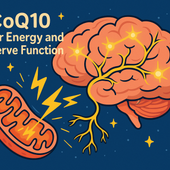
CoQ10 for Energy and Nerve Function
CoQ10 powers every cell in your body—from your heart to your brain ⚡. Learn how this essential compound fuels mitochondria, boosts nerve function, and protects your brain from oxidative stress. Discover how supplementing with CoQ10 can restore energy, sharpen focus, and support long-term neurological vitality.
-
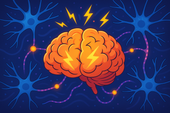
Supplements That Support Nerve Signaling for Mental Energy
Your brain’s electrical network depends on magnesium—one of the most vital minerals for nerve signaling, calm focus, and steady mental energy ⚡. Learn how this essential nutrient powers neurotransmission, supports relaxation, and helps protect your nervous system from stress overload—so your mind feels balanced, alert, and resilient every day.
-

L-Theanine for Sleep Without Grogginess
L-theanine offers a natural path to better sleep—without the next-day fog. 🌙 Found in green tea, this gentle amino acid calms the mind, lowers stress hormones, and promotes deep relaxation without sedation. Learn how L-theanine balances your brainwaves, reduces nighttime anxiety, and helps you wake up refreshed, alert, and clear-minded.
-

Supplements to Support the Circadian Rhythm
Your body’s natural clock depends on more than just sunlight—it also relies on key nutrients to stay in sync. 🌞🌙 Discover the best supplements to support your circadian rhythm, from melatonin and magnesium for deep sleep to vitamin D and adaptogens for morning energy. Learn how to realign your internal clock for better rest, sharper focus, and stable mood every day.
-

Melatonin and Cortisol: The Night vs. Day Hormones
Melatonin and cortisol are your body’s night-and-day hormones—one helping you drift into deep sleep, the other powering your alertness each morning. 🌙☀️ Learn how these two forces work together to regulate your energy, mood, and recovery. Discover how modern stress, artificial light, and poor routines can throw them off balance—and how to naturally reset your rhythm for calm nights and focused days.
-

Supplements for Deeper Sleep and Nervous System Reset
Struggling to sleep even when you’re exhausted? 🌙 Discover how to reset your nervous system and achieve deeper, more restorative rest with the right blend of supplements, breathwork, and therapy. From magnesium and L-theanine to slow exhalations and somatic healing, this guide helps you rebuild your body’s natural rhythm of calm and recovery—so you can wake up truly renewed.
-
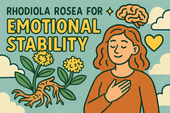
Rhodiola Rosea for Emotional Stability: Finding Balance Through Resilience
Stress is the body’s natural alarm system — useful in bursts, but draining when it never turns off. Learning to regulate it helps restore calm focus, emotional balance, and physical vitality. 🌿💫
-
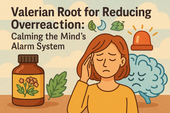
Valerian Root for Reducing Overreaction: Calming the Mind’s Alarm System
GABA is the brain’s natural brake pedal — calming overstimulation and helping you think clearly under stress. When balanced, it brings a sense of inner peace, emotional control, and focus. 🌿🧠💫
-

Supporting Adrenal Health for a Steadier Mood
Cortisol is the body’s built-in stress alarm — essential in short bursts but harmful when constantly elevated. Learning to balance it naturally restores calm, focus, and emotional stability. 🌿⚖️
-

Cold Showers and Adaptogens for a Reset: Reclaiming Energy, Calm, and Control
Adaptogens help the body adapt to stress, restoring calm energy and balance. These ancient herbs strengthen resilience, regulate mood, and support focus — helping you stay grounded through life’s ups and downs. 🌿💫
-
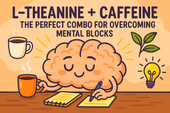
L-Theanine + Caffeine: The Perfect Combo for Overcoming Mental Blocks
Neurotransmitters are the brain’s messengers — tiny molecules that shape how we think, feel, and focus. When they’re in balance, we experience calm energy, clear thinking, and emotional harmony. 🌿🧠✨
-
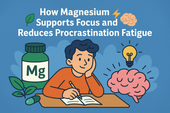
How Magnesium Supports Focus and Reduces Procrastination Fatigue
Magnesium is the quiet mineral behind mental clarity and steady focus. By calming the nervous system and restoring cellular energy, it helps transform fatigue and overthinking into calm, productive flow. 🌿⚡🧠
-

B Vitamins for Beating Procrastination and Boosting Energy
Procrastination isn’t just a mindset — it’s often a signal of low energy and nutrient depletion. B vitamins recharge the brain’s motivation circuits, boosting focus, clarity, and the drive to take action. 🌿⚡🧠
-
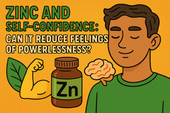
Zinc and Self-Confidence: Can It Reduce Feelings of Powerlessness?
Zinc isn’t just a mineral — it’s the foundation of emotional strength. By balancing neurotransmitters and calming the nervous system, it helps you feel more centered, assertive, and confident from the inside out. 🌿💪
-

How Vitamin D Deficiency Impacts Emotional Resilience in Co-Dependent Patterns
Co-dependency is the emotional tug-of-war between connection and self-loss — a pattern born from giving too much and receiving too little. Learning to untangle this dynamic allows for real love rooted in balance, not fear. 🌿💛
-

B Vitamins for Mood Stability and Self-Worth in Co-Dependency
Vitamin B1, or thiamine, powers both the body and the brain — fueling focus, energy, and emotional clarity. Supporting your nervous system with this essential nutrient helps restore calm and mental resilience. 🌿⚡🧠
-
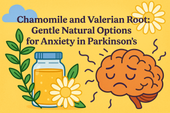
Chamomile and Valerian Root: Gentle Natural Options for Anxiety in Parkinson’s
Anxiety often feels like a storm inside the mind — racing thoughts, tightness, and unease that make it hard to focus or rest. But learning to understand and calm that inner storm opens the door to peace and emotional balance. 🌿🧠
-
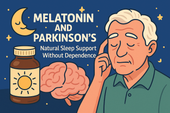
Melatonin and Parkinson’s: Natural Sleep Support Without Dependence
Melatonin is the body’s natural sleep hormone — guiding your mind into rest and your body into recovery. Supporting its natural rhythm can improve sleep quality, mood, and overall health without dependence. 🌙🧠
-
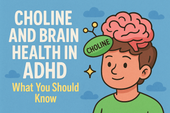
Choline and Brain Health in ADHD: What You Should Know
Inflammation can quietly affect both the body and mind, disrupting focus, mood, and energy. Understanding how it works — and how to calm it — is key to restoring balance, clarity, and long-term health. 🌿🧠
-
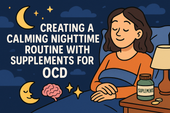
Creating a Calming Nighttime Routine with Supplements for OCD
Sleep is the brain’s nightly repair ritual — a time when emotional chaos settles and clarity returns. Prioritizing deep rest restores focus, calm, and resilience, helping both the body and mind recover naturally. 🌙🧠
-
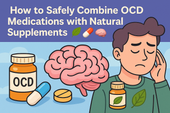
How to Safely Combine OCD Medications with Natural Supplements
Supplements bridge the gap between nutrition and mental wellness — supporting focus, calm, and energy from within. The right combination of nutrients can help balance mood, sharpen the mind, and restore long-term resilience. 🌿🧠
-
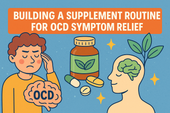
Building a Supplement Routine for OCD Symptom Relief
OCD can feel like being trapped in your own thoughts — a battle between control and chaos. Understanding the science behind these cycles is the first step toward breaking free and finding calm within the mind. 🌿🧠
-
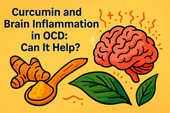
Curcumin and Brain Inflammation in OCD: Can It Help?
Inflammation doesn’t just affect the body — it can silently influence the brain, fueling anxiety, fatigue, and mental fog. By understanding how inflammation works, we can learn how to calm the nervous system and restore inner balance. 🌿🧠
-
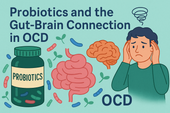
Probiotics and the Gut-Brain Connection in OCD
Serotonin, often called the “feel-good” chemical, shapes our mood, focus, and emotional balance. By keeping this neurotransmitter in harmony, we support calm thinking, better sleep, and greater mental resilience. 🌿🧠
-

B Vitamins and OCD: Supporting Energy and Neurotransmitter Balance
OCD isn’t just about habits — it’s about the brain’s struggle to find control in chaos. Understanding the neurological roots behind intrusive thoughts can help replace fear with clarity and guide healing toward calm awareness. 🌿🧠
-
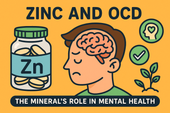
Zinc and OCD: The Mineral’s Role in Mental Health
Zinc is more than a trace mineral — it’s a key regulator of mood, memory, and emotional balance. By stabilizing neurotransmitters like serotonin and glutamate, zinc helps calm obsessive thought patterns and supports overall mental clarity. 🌿🧠
-

N-Acetylcysteine (NAC) and OCD: Promising Research Findings
Antioxidants act as the body’s natural defense system, neutralizing free radicals that damage brain cells and worsen anxiety or fatigue. Supporting antioxidant balance with nutrition and supplements helps protect focus, memory, and emotional stability. 🌿🧠
-
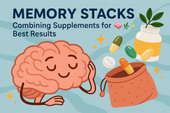
Memory Stacks: Combining Supplements for Best Results
Memory weaves the story of who we are — connecting past, present, and future through every experience we store and recall. Strengthening memory means nurturing the brain’s energy, balance, and emotional calm so learning becomes effortless. 🌿🧠
-
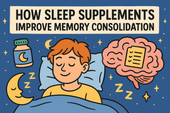
How Sleep Supplements Improve Memory Consolidation
Stress can cloud thinking, disrupt sleep, and weaken memory — but understanding its effects on the brain is the first step toward calm. By learning to regulate the nervous system, we can protect focus, energy, and emotional balance. 🌿🧠
-
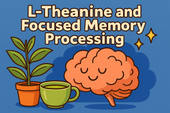
L-Theanine and Focused Memory Processing
Science is the art of curiosity and precision — a quest to understand the unseen patterns that shape life. From molecules to galaxies, every discovery begins with observation, imagination, and the courage to ask “why.” 🔬💡
-
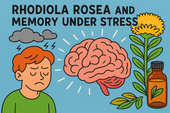
Rhodiola Rosea and Memory Under Stress
Stress clouds memory, slows thinking, and drains energy — but the good news is, the brain can recover. By understanding how stress affects focus and emotion, we can learn to regulate it, restore clarity, and protect long-term cognitive health. 🌿🧠
-
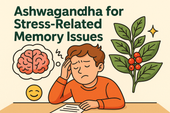
Ashwagandha for Stress-Related Memory Issues
Adaptogens are nature’s answer to modern stress. These powerful herbs — like Ashwagandha, Rhodiola, and Holy Basil — help balance cortisol, support calm focus, and strengthen the body’s resilience, bringing the mind back to harmony. 🌿🧘♀️


















































